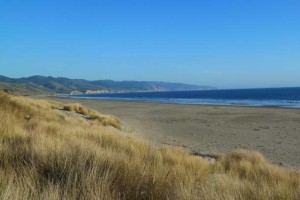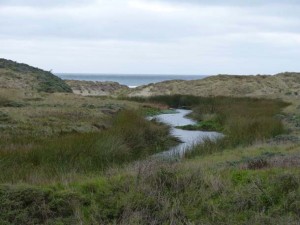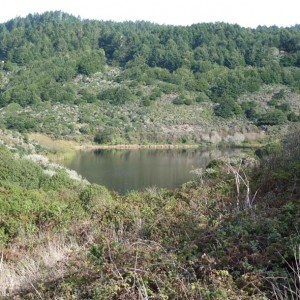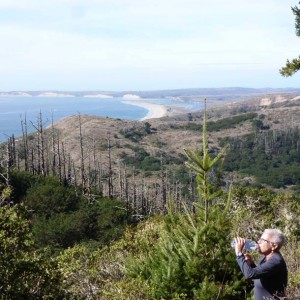This is part of a year-long effort to hike every trail at Point Reyes National Seashore, which turned 50 in 2012. Learn more.
Drake’s Head via Estero Trail (1.7 miles of “new” trail, but 8.2 miles round trip.) Difficulty: Easy to moderate with several muddy sections.
Something about a solitary walk across a peacable landscape, the solace offered by solitude, that unravels inner tangles. One step at a time with no sense of what one will next encounter, no matter assumptions and schedules, the unanticipated miracles of nature left to her own devices.
People usually consider walking on water or in thin air a miracle. But I think the real miracle is not to walk on water or in thin air, but to walk on earth.
—Thich Nhat Hahn in “The Miracle of Mindfulness.”
My friend Anne Murphy drops me at the trailhead on her ATV and I follow out the fenceline toward Drake’s Head. The fenceposts are all tarted-up with lichens, a testament to the salubrious marine air that breathes off the Pacific. The cooperative exchange of nutrients between the fungus and algae that creates lichens (and has for millennia) is a lesson in survival through cooperation, a lesson that sometimes seems lost on our meshugenah species. (These are my thoughts after an election season and the local controversy of the month.)
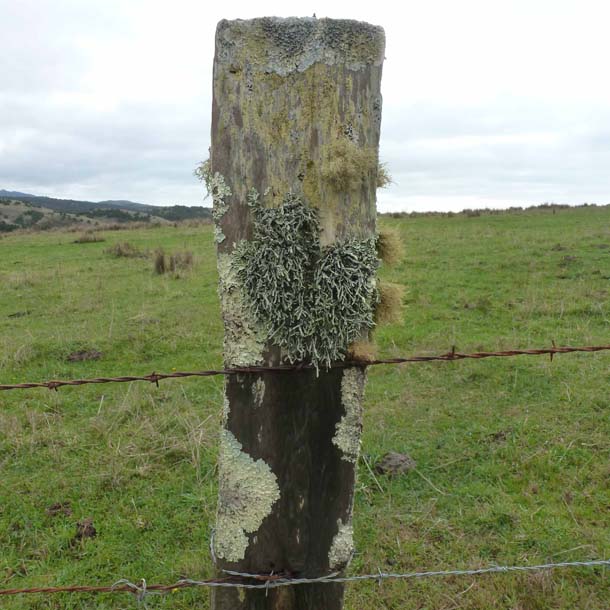
Farther along, the fenceline intersects a ranch road where the recent rains have eroded the soil, exposing the substrate, layers of sandstone laid down beneath the sea in an ancient era, uplifted and twisted by indomitable tectonics, but the sequence of deposition is still vsible.
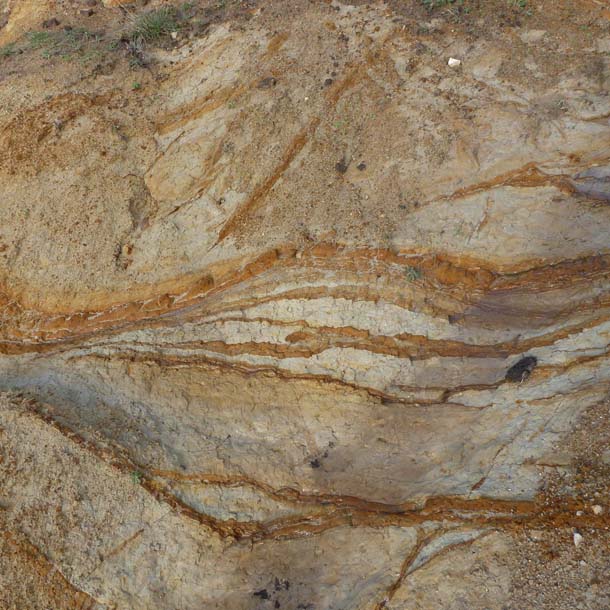
The “pastoral zone” through which the trail passes is actually coastal prairie that has been converted to annual grasslands by over a century of grazing pressure. The change from a diverse mosaic of perennial bunchgrass and shrubbery characteristic of prairie to the sparser near monoculture of European grasses has reduced the bio-complexity of the habitat.
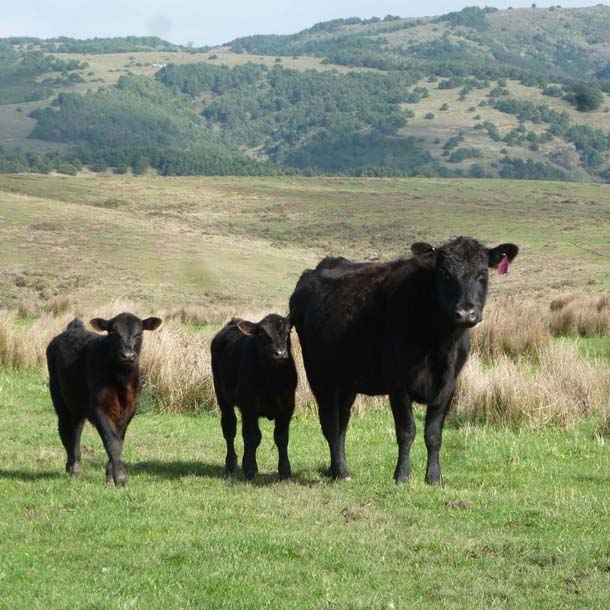
But some wild creatures still persist in the pastoral zone. Probably the most abundant bird in heavily grazed pastures is the Savannah Sparrow, a small seed-eating passerine that lives here year-round and nests in clumps of grass on the ground.
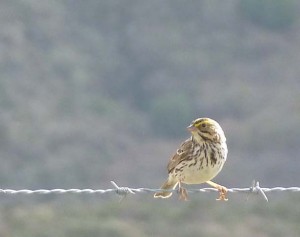
We’ve had enough rain so far this year that the ground is nearly saturated, the grasses have turned winter green, and ephemeral winter pools have formed. Although short-lived, these small ponds provide insects and Pacific chorus frogs (aka “treefrogs”) alike with habitat.
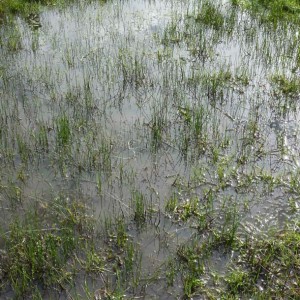
Any walk in nature, no matter how seemingly unremarkable, offers surprises. As I approach a large pile of rocks—apparently dumped here to be used for erosion control—a Burrowing Owl pops out of the pile and lands on a nearby fencepost, bobbing in place as he watches me pass. This owl likes open country—pastureland, coastal dunes, and barren ground—where it eats insects and small rodents. Jerusalem crickets seem to be a favored food. “Billy owls” are rather uncommon here, spending only the fall and winter months. There are no nesting records for the peninsula. Although the habitat appears appropriate, ground squirrels, which provide the burrow systems for this owl’s nesting needs, are absent here. As early as the 1940s, Grinnell and Miller (Birds of California) noted the decline of Burrowing Owls attributing it to “anti-‘varmin’ campaigns, elimination of ground squirrels—hence of nesting places for these owls.”
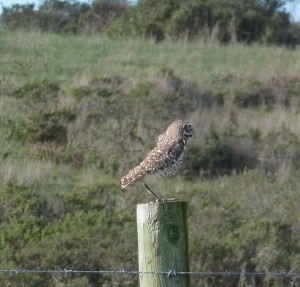
Past a cattle corral, the inner reaches of Limantour Estero come into view and the viewscape opens up toward the Farallone Islands.

Here a sign says “Drakes Head Trail 1.6 miles” but “trail’ may be too grand a word for the route. It’s really a barely visible cow path, severely eroded in sections; its direction becomes difficult to discern for several stretches. Just head west.
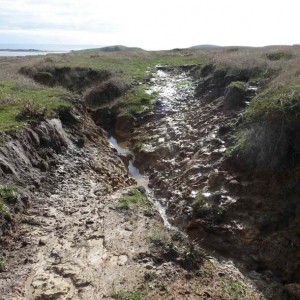
After passing an old ranch settlement, marked by several large Eucalyptus trees and some remnant watering troughs, the intrepid hiker crests a small rise and comes to Drake’s Head. The view of the Limantour estero and Limantour Spit, Drake’s Bay, the outer peninsula, and beyond to the Farallones is perhaps the most stunning perch in the park. On a calm day like today flocks of hundreds of Black Brant are feeding in the eelgrass beds, a few White Pelicans sail past, and harbor seals are lolling on the water’s surface. Not a person in sight. The water is murky from the recent rains, but on clear water days one might be looking down on squadrons of leopard sharks or bat rays foraging beneath the surface.
I sit on the headland awhile, watching the waterfowl and seals going about their business, making the world anew.
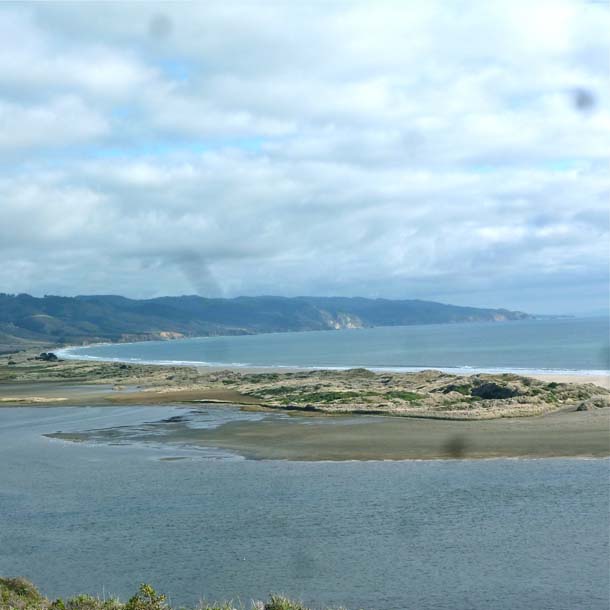
A thing is right when it tends to increase the integrity, stability, and beauty of the biotic community. It is wrong when it tends otherwise.
—Aldo Leopold in “A Sand County Almanac.”
Leopold’s trenchant observation runs through my mind as I sit here, two days after the Federal Register affirmed Point Reyes Wilderness status (December 4, 2012). This affirmation, astutely crafted in 1976, had finally been realized despite the Orwellian efforts of many to undermine the original intent of the Wilderness Act.
Today, something seems right with the world.
Acknowledgements. Thanks to Anne Murphy for friendship and access through her ranch. Point Reyes Outdoors provided a mountain bike, which I did not use on this outing, but was much appreciated. And, of course, thanks to Dan Rademacher and David Loeb of Bay Nature for their ongoing support of the 2012 Point Reyes Walkabout.
Critter list
Insects
Tussock Moth
Jerusalem Cricket
West Coast Lady
Herps
Pacific Chorus Frog
Red-legged Frog
BIRDS
Brant
Canada Goose
American Wigeon
Surf Scoter
Bufflehead
Red-breasted Merganser
California Quail
Red-throated Loon
Pacific Loon
Common Loon
Horned Grebe
Eared Grebe
Western Grebe
American White Pelican
Double-crested Cormorant
Great Blue Heron
Great Egret
Turkey Vulture
Osprey
Ferruginous Hawk
American Kestrel
American Coot
Killdeer
Willet
Marbled Godwit
Dowitcher sp.
Red Phalarope
Ring-billed Gull
California Gull
Western Gull
Burrowing Owl
Northern Flicker
Black Phoebe
Say’s Phoebe
Western Scrub-Jay
American Crow
Common Raven
Bewick’s Wren
Golden-crowned Kinglet
Ruby-crowned Kinglet
Western Bluebird
Wrentit
European Starling
American Pipit
Yellow-rumped Warbler
Townsend’s Warbler
California Towhee
Savannah Sparrow
Fox Sparrow
Song Sparrow
White-crowned Sparrow
Golden-crowned Sparrow
Brewer’s Blackbird
House Finch
American Goldfinch
Mammals
Raccoon (tracks)
Bobcat
Gray fox (scat)
Coyote (tracks)
Stripped Skunk (tracks)
Tule Elk

